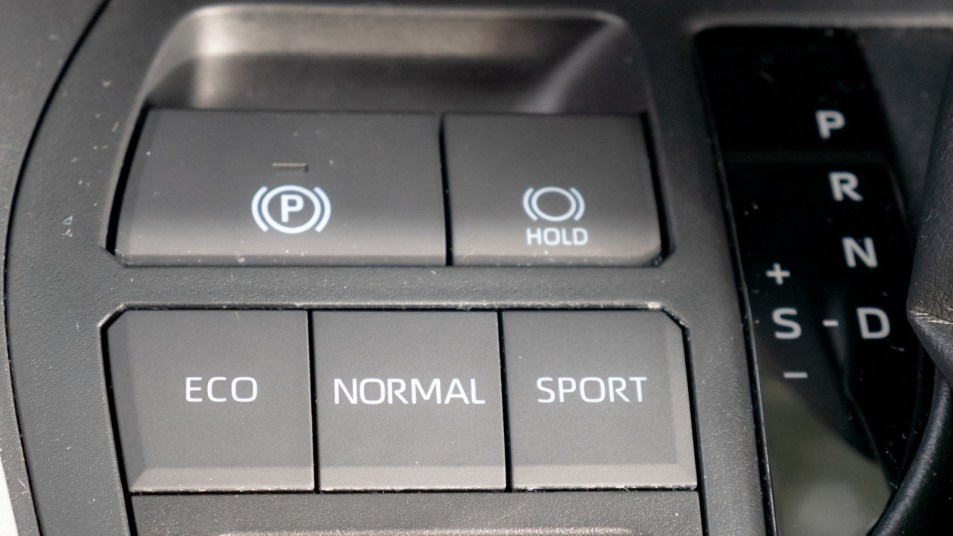Many of today’s new cars provide driving modes, including Eco mode (EM). Driving modes allow you to at least somewhat tailor your car’s performance to your preferences. These various modes influence how your engine responds to accelerator input, how the transmission shifts, and more.
In theory, each mode provides a specific response to driver input.
Although the modes may vary from model to model, there is almost always an EM.
Which begs the question: What is Eco mode?
What is Eco Mode?
Eco mode, in a nutshell, is a fuel-saving technology engineered to maximize a vehicle’s fuel efficiency. You can find this feature on many cars, even used cars.
The downside of EM is, a loss of responsiveness accompanies this mileage increase. In other words, picking EM is a tradeoff between improved fuel economy and performance.
Different models provide different methods for switching among modes. Sometimes you may find buttons marked Normal, Eco, Sport, and so forth. Setting a mode might be through a knob on the center console in other models.
No matter how you select modes, a message light in the gauge cluster usually illuminates to alert you to the mode picked.
Engaging EM changes the way the engine responds to throttle input. It often quickens transmission upshifts and affects the air and fuel combustion mixture.
From the driver’s seat, you will notice some reduction in the vigor with which your vehicle accelerates. This may include upshifts at lower revolutions per minute (RPMs) and more leisurely downshifts. It may even involve skipping first gear entirely.
Even drivers who have a lighter foot on the accelerator may notice a change in performance when in Eco mode.
The bottom line: In virtually every application, Eco mode stretches a gallon of gas.
What Does Eco Mode Do?
We’re not going to dig too deeply into how the sausage is made. However, the key to EM is your automatic transmission.
Eco mode reprograms your automatic transmission to be less aggressive. That means minimizing how hard the engine works by upshifting earlier than usual. This artificially prevents the engine from increasing its RPMs.
When an engine doesn’t work as hard, it consumes less fuel.
Moreover, the transmission isn’t as quick to downshift as your car slows down. Likewise, when you punch the accelerator to pass another vehicle, the transmission may hesitate a second or two before downshifting to boost acceleration.
In EM, your engine won’t respond as quickly to throttle inputs. Your engine adjusts itself, producing a less urgent response to increased pressure on the accelerator.
More sophisticated Eco technologies will also lower the fuel-to-air ratio in the combustion chamber. Among the Eco mode tricks is reducing power to some systems having nothing to do with the powertrain. They might include reducing power to the climate control system.
Every Eco mode is a multi-prong approach to increasing fuel efficiency to varying degrees.
When Should You Use Eco Mode?
You should engage EM any time you are willing to trade a little performance to squeeze a few more miles out of a tank of gas.
It is more effective in city driving than on the highway because it primarily affects acceleration. Although you can engage EM any time, it will have much less impact on fuel economy when touring down the highway. As with hybrid vehicles (HEV), most fuel savings are in city driving.
What is Eco Mode’s Effect on Fuel Economy?
Eco mode’s actual effect on mileage depends on the specific vehicle and a driver’s particular driving style. As mentioned earlier, if 80% of your driving is on the highway, the rewards will be less than if 80% is on city streets.
Experts put the average fuel savings at roughly 5%. That means, if you usually get 500 miles out of a tank of gas, EM will contribute another 25 miles to 525 miles on a tank.
Based on two tanks of gas per month (1,000 miles of driving), driving in Eco mode for a year will stretch the mileage to roughly 12,600 miles.
What are the Environmental Impacts?
We’re not sure how significant a benefit to the environment driving in EM actually is.
What we are sure of, though, is anytime your vehicle burns less fuel, it’s spitting out fewer CO2 emissions.
And, every little bit helps, right?
What are the Disadvantages of Eco Mode?
The main drawback to Eco mode is a less responsive, less aggressive driving experience.
For those who enjoy a sporty driving experience, EM will sap some of the fun from your time behind the wheel.
Moreover, in models with more sophisticated Eco mode systems, you may not be pleased with the system reducing the effectiveness of the air conditioning in August.
However, you are free to engage it and disengage it at your pleasure.











